Coverage of the Canmore World Cups was made possible through the generous support of Travel Alberta and Tourism Canmore.
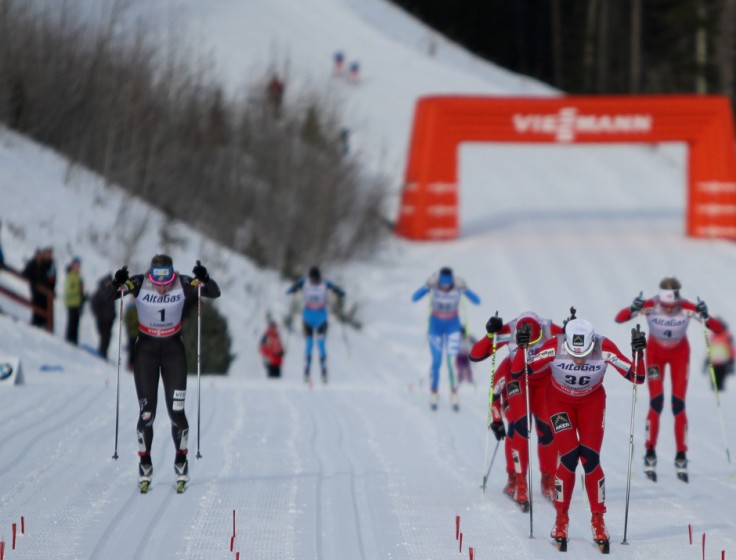
CANMORE, Alberta — Kikkan Randall (USA) didn’t finish where she started, but she knows she is headed in the right direction.
In a season of firsts, Randall set yet another personal mark, posting her best World Cup classic distance result while starting in bib No. 1 in the mass start.
The Anchorage, Alaska native finished sixth after battling to the line with four other women, all gunning for the final podium spot.
“I wanted to try to be in the fight and I was just off, so I’m happy with it,” Randall told FasterSkier in the finish area.
The three-lap race featured a long sustained climb to a high point with a World Cup points preem on the second lap. Despite the challenging course, the pace was hard from the get-go, with eventual winner Justyna Kowalczyk (POL) pushing at the front.
Randall said she expected this and stuck to her game plan.
“I just tried to make sure to start the race at my own pace knowing that things would have to come back together in the middle,” she explained.

The race did exactly that — the chase group compressing after Kowalczyk gapped the field. Randall said she started feeling stronger on the second lap, her restrint paying off.
On the final climb, a shorter pitch after the long descent from the top, Randall attacked, moving past a group of Norwegian women.
“I thought maybe if I made a good enough charge over the top of the hill maybe I could break their spirits a little bit,” she said.
She didn’t quite have enough to get away headed into the final descent, however, setting up the sprint for the finish.
With Anne Kylloenen (FIN) breaking away earlier in the last loop to secure second, the race was for third.
Randall had her work cut out for her, matching up against the Norwegians.
She slipped in behind Vibeke Skofterud coming out of the downhill, looking to maximize the draft for the long finish stretch.
Many races are won and lost coming out of the final descent in Canmore. Play it right and a skier can shoot past her competition, miscalculate and she will watch her opponents leave her in the dust.
Randall’s position was solid, but not good enough.
“I didn’t quite play my cards right,” she said.
When she stepped out from behind Skofterud, she pulled even, but no better.
Meanwhile Maiken Caspersen Falla, runner up to Randall in the Sprint Cup last season, waited patiently at the back of the group.
She came flying by, generating the speed to support her strong finishing kick, and skied clear for third.
Both Skofterud, and yet another Norwegian, Ingvild Flugstad Oestberg, made it by the American in the final 100 meters.
“I still have some work to do on my double pole,” Randall said.
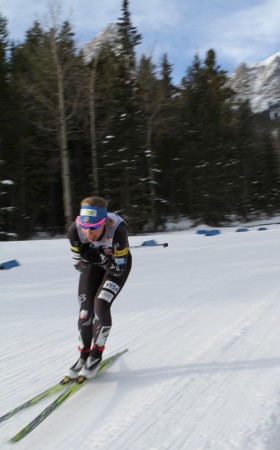
Still, she had no complaints.
“It was a good hard effort. That was my number one goal for today,” she said.
Limited by a stress fracture in her foot for most of the fall, Randall has yet to find her top classic form. Her training consisted of double poling and lots of time on the bike and in the pool.
“I think that is why my skating is so good — just because I was doing a lot of steady work in the legs,” she explained “But classic skiing takes that really quick impulse on the climbs and I didn’t do any bounding.”
Each race effort should bring continued improvement. Right now, she said, “the good feelings aren’t quite there yet,” in classic skiing, a sign of better results to come.
Wearing bib #1 in a World Cup mass start was a first for Randall, an experience she described as “fun.”
The number that ultimately matters, however, is to be found at the end of the race.
“I know I can be bib #1 [at the finish] here pretty soon, and I am excited to be close, but it is still going to take a little bit,” Randall said.
***
Taking a page out of the Norwegians’ book, the U.S. stacked the top of the start list, with Holly Brooks #3, Liz Stephen #6 and Jessie Diggins #12 behind Randall.
But Stephen and Diggins were late scratches due to illness.
U.S. Ski Team (USST) Women’s Coach Matt Whitcomb described the issue as “maybe mild colds.”
He said that while today’s race was a great opportunity for top results for both women, “we just weren’t confident to race them today.”
The hope is that they will be ready to go on Saturday, but with Tour de Ski on deck, Whitcomb said they won’t push it.
“They just felt really run down yesterday and this morning,” USST Head Coach Chris Grover added. “I think for both of them they realize that even though today could’ve been a great race for them, they maybe have stronger potential races in terms of the formats coming up this weekend.”
Brooks, however, was healthy, if a bit fatigued, and enjoyed the experience of heading out at the front of the field.
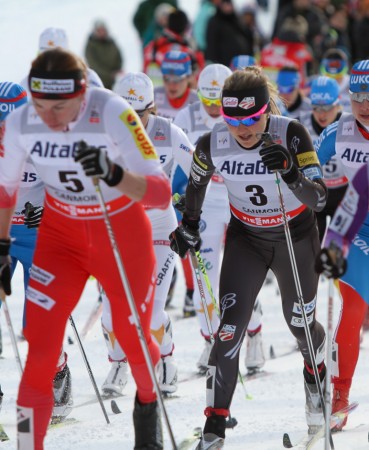
“It is so fun starting at the front of a mass start. You just avoid so much chaos,” she said.
She was happy with her start, feeling “in control” for the first half of the race. She spent time toward the front, right behind Kowalczyk, but ran into trouble on the second lap, and quickly dropped back through the pack.
The wheels started to come off at the top of the big climbs the second time. She described her body as completely flooded with lactate.
“My arms just felt like lead, my legs felt like lead… I guess it just caught up with me really fast,” Brooks said.
Pointing too an intense first period of World Cup racing where she has contested every event, she is feeling tired.
“I just maybe need a little more rest,” she said. “I know I can ski a lot faster than that.”
She did manage to hang on and earn a single World Cup point for her efforts, placing 30th.
Her teammate Ida Sargent was just meters behind in 31st after trying to battle up through the field.
“I just wasted a lot of energy trying to get up there in the beginning,” Sargent explained.
She started toward the back at bib #44, and while her aggressive start did not pan out she is not sure if she would have done anything differently.
“It is kind of tough — I didn’t want anyone to get away. So it was what you gotta do,” she said.
Whitcomb, however, pointed to pacing as the key to the race, noting that Randall, and Sadie Bjornsen, who placed 25th did quite well on that front.
“The goal for today was get some kick, ski light and turn it up as the race went on,” he said.

Both Randall and Bjornsen were able to attack on their final laps, staying within themselves early on.
“Everybody has to ski within their own parameters because you can have some catastrophic explosions at altitude,” Whitcomb said. “Feathering the gas pedal is what you have to do here.”
“I tried to just focus right in front of me,” Bjornsen said. “If you’re paying attention enough to everyone around you can waste a lot of energy because you’re like, ‘Oh! I’ve gotta go!’”
She added that many of the World Cup women ski with such a high tempo that she couldn’t lock in behind. She found herself looking for her own track and some space.
“A standout race” Grover described Bjornsen’s effort.
Overall she was happy with her race on the tough Canmore course, a sentiment that teammate Rosie Brennan seconded.
Brennan, who like Bjornsen races for the Alaska Pacific University Ski Club, placed 35th.
She found starting at the back challenging on the hilly terrain. Every time the pack hit a hill, she would be forced to slow down as the race compressed, only to have to sprint stay in contact when the field started moving.
“It took a little while to find your rhythm,” she said.
The hills and firm rail-like Canmore tracks also provided an additional challenge — racing domestically all fall, Brennan hadn’t experienced either this season.
“It was relatively flat [previous races] compared to this, and this is the first time we’ve skied in tracks this year, real tracks…It was awesome to ski on a real race course with good tracks and everything but it also takes a little bit of adjustment,” Brennan said.
The U.S field was rounded out by Sophie Caldwell in 43rd, Chelsea Holmes in 47th, and Caitlin Patterson in 50th.
Brittany Webster led the Canadians in 38th, an improvement over her 2010 World Cup result in Canmore, where she was 57th in a 10 k freestyle race. And on Thursday, she fell twice.
“The first lap I crashed twice and that didn’t really help,” Webster said. “The second lap it took a little while to get my feet back under me and by the time the third lap came I felt like I had a groove back again.
“It’s great to just see the consistency coming again,” she added. “I knew that if all the stars aligned I could have a good race and even though it wasn’t perfect out there, it was pretty great. My skis were phenomenal, and yeah, I was just proud that I stayed relaxed and just enjoyed the whole process.”
— Alex Matthews contributed reporting
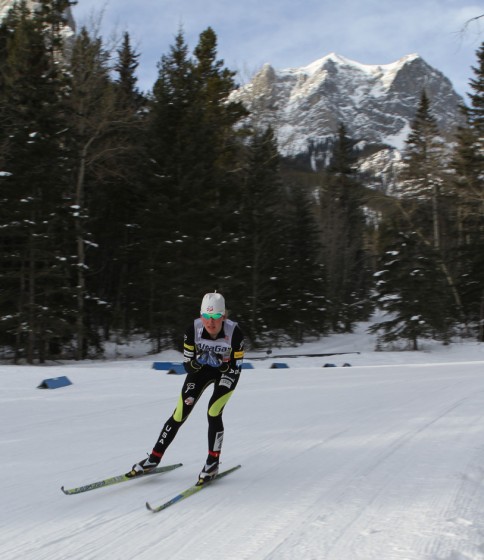
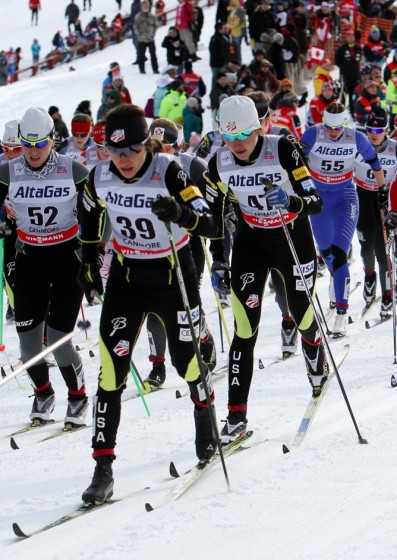




One comment
Martin Hall
December 14, 2012 at 6:05 pm
It was obvious in watching the race that Kikkan had the slowest skis of that group of ladies she was around–she had just sprinted to the front of the group on the last uphill and started the downhill in the front of the group—-by the bottom she was at the back of the group. Can’t hit everything everyday—but she sure has that extra gear when she needs it–the final 100 to 200 meters of the sprint in Quebec—she just opened up the throttle and all of a sudden she won by over a second—did the same thing on the last uphill on Thursday. She is also skiing her races very smart right now—can’t wait to see her and the other NA ladies tomorrow.